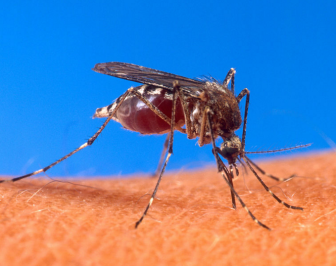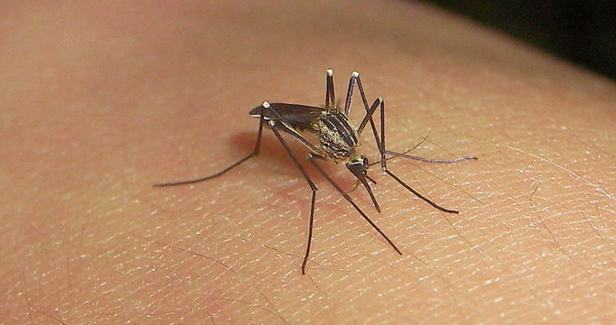Today, Monday, the DPH reported that mosquitoes positive for WNV have been found in Darien.
— an announcement from the Darien Health Department
Finding mosquitoes positive for WNV commonly occurs each year at this time, not only in Darien but in many locations throughout the state. It is important to note that NO cases of West Nile Disease have been diagnosed in Connecticut residents thus far this year.
Here are a slew of things you can do to make it less likely a mosquito will bite you, your family or anyone else around your home:
What the State Is Doing About Mosquitos
As it does every year, the state Mosquito Management Program is monitoring mosquitoes for the presence of viruses that can cause illness in people including West Nile virus (WNV), Eastern equine encephalitis virus (EEE) and ZIKA.

Mosquito
Aedes Aegyptae biting a human (U.S. Agriculture Dept. photo, via Wikimedia Commons)
The mosquito trapping and testing program, coordinated by the Connecticut Agricultural Experiment Station (CAES), began in June and continues through October.
The CAES maintains a network of mosquito-trapping stations in municipalities throughout the state with two traps located in Darien. Mosquito trapping is conducted at each site every 10 days on a rotating basis. Mosquitoes are grouped (pooled) for testing according to species, collection site, and date.
Test results are available about one week after mosquito collection and positive results are reported to local health departments by the state Department of Public Health (DPH).
How to Protect Yourself From Mosquitos
To reduce the chance of being bitten when outside, wear protective clothing such as long sleeves, long pants and head cover. Light-colored, loose-fitting clothing is preferable because dark clothing radiates more heat and attracts more mosquitoes.

Aedes mosquito (Photo by Danny Steaven on Wikimedia Commons)
Insect repellents containing DEET, picaridin, IR3535 or oil of lemon eucalyptus can be used by most people and are often effective for varying lengths of time.
Permethrin, a synthetic pyrethroid that is widely available for repelling and killing ticks, also repels and kills mosquitoes. It is applied to clothing and provides longer-lasting protection. Do not apply permethrin products directly to skin.
Although not marketed as repellents, there are several cosmetic liquids and creams that claim some level of mosquito repellency. These products may effectively repel when mosquito pressure is light, but need to be reapplied frequently.
The U.S. Environmental Protection Agency (EPA) provides further information on the use and effective use of repellants.
Minimizing the time spent outside at dusk and dawn will reduce the potential exposure to mosquito bites.
What Else You Can Do
You can help with managing the mosquito “problem” but you need to realize that part of what makes this area so pleasant for us is what encourages the mosquitoes to be here as well — the presence of water.
(In general, natural ponds and lakes are not sources of mosquito breeding, because permanent bodies of water usually contain fish and other predators that would consume mosquito larvae.)
One of the easiest and surest ways to manage mosquitoes around the home is to eliminate standing water where mosquitoes can lay eggs. Mosquitoes need at least 7 to 10 days in water to fully develop.
Some common sources of mosquitoes around the home are:
• Artificial containers that hold water (e.g., pails, paint cans, discarded tires)
• Boat or pool covers or tarps that collect rain water
• Unmaintained bird baths, rain barrels or wading pools
• Clogged or poorly maintained roof gutters
• Rot holes in trees and stumps
Practice Good Sanitation Around Your Home
• Homeowners should properly dispose of or recycle trash that can hold rainwater.
• Make it a practice to flush birdbaths and wading pools weekly.
• Swimming pool filtering systems should be maintained and in good working order.
• Abandoned pools should be drained, filled or “shocked” with pool chemicals.
• Openings for standing water sources, such as rain barrels, can be sealed or covered with screening.
• Rotten stumps and tree holes can be filled with sand.
• Discarded tires should be disposed of properly, holes (0.5 inches or larger) can be drilled in the bottom of the tires to drain rainwater or the tires can be stacked and covered to prevent rainwater from entering.
• Ornamental pools and aquatic gardens can become sources of mosquitoes if the water is allowed to stagnate. Water should be changed frequently or an aerator can be installed. Insecticides, such as those containing the bacteria.
• Bacillus thurgiensis israelensis (Bti), are available at many nurseries and garden supply centers and can be used to treat mosquito breeding sites on your property.
Ways to Minimize Contact
There are also ways homeowners can minimize the annoyance caused by adult mosquitoes.
• Key Locations: Mosquitoes prefer to rest in shady, calm areas and avoid open sunny, breezy areas.
• Mowing tall grass will reduce places where mosquitoes can rest.
• Timing and Weather: Again, mosquitos are most active around dawn and dusk although some, such as the common saltmarsh mosquito, may be active throughout the day or may be more active during cloudy, humid weather. Simply avoiding outdoor activity during these peak mosquito times can minimize contact with mosquitoes.
Enjoy the summer — and don’t forget the sunscreen!
Learn More
You can find more information on these websites:
• Connecticut Department of Public Health
• CT DPH Mosquito-borne Diseases
